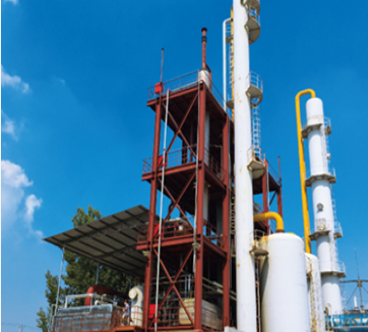脫水工藝
Dehydration process
沼氣脫水是因為導(dǎo)氣管中如果積累了水會溶解硫化氫腐蝕管道。此外�����,當(dāng)沼氣被加壓儲存時��,沼氣中的水會凝結(jié)凍壞儲氣罐���。其脫除方法如下:
The reason for the dehydration of biogas is that if water accumulates in the gas conduit, it will dissolve hydrogen sulfide and corrode the pipeline. In addition, when the biogas is stored under pressure, the water in the biogas will condense and freeze the gas storage tank. The removal method is as follows:
冷凝法
Condensation method
不同的溫度下沼氣中飽和水蒸汽的含量不同,在35℃時水的含量接近5%����,在輸入天然氣網(wǎng)前沼氣中的水必須去除����。針對不同的凈化工藝���,在各個階段有不同的方法�����。在壓縮之前需除去冷凝水��,這樣�,在洗滌去除二氧化碳和硫化氫工藝中就不需要再針對氣體進行干燥��。在吸收凈化工藝之前也常常需要對氣體進行干燥����,主要有冷凝法和吸附法,常用的為冷凝法��,即在熱交換系統(tǒng)中通過冷卻器冷卻氣體而除去冷凝水��。這種方法由于是在熱交換器的表層冷卻���,通常比露點低0.5℃-1℃��,為了取得更低的露點�����,必須在冷凝之前先壓縮氣體����,然后再釋放到需要的壓力。
The content of saturated water vapor in biogas is different under different temperatures. At 35 ℃, the content of water is close to 5%. The water in biogas must be removed before it is put into the natural gas network. For different purification processes, there are different methods in each stage. The condensate needs to be removed before compression, so that there is no need to dry the gas in the process of washing and removing carbon dioxide and hydrogen sulfide. Before the absorption and purification process, it is often necessary to dry the gas, mainly including condensation method and adsorption method. The most commonly used method is condensation method, which is to remove the condensate water by cooling the gas through the cooler in the heat exchange system. This method is usually 0.5 ℃ - 1 ℃ lower than the dew point due to the surface cooling of the heat exchanger. In order to obtain a lower dew point, the gas must be compressed before condensation, and then released to the required pressure.

吸附干燥
Adsorption drying
吸附干燥是指通過硅膠����,氧化鋁或氧化鎂等干燥劑來吸收氣體中的水分��,待干燥的氣體通過吸附床中的干燥劑被干燥�。通常使用兩套裝置,當(dāng)一個工作的時候���,另外一個可以再生��。干燥劑的再生可以通過兩種途徑�����。一種是可以用一部分(3%-8%)的高壓干燥氣體再生干燥劑��,這部分氣體可以重新回流至壓縮機人口���。另外一種是在常壓下用空氣和真空泵來再生干燥劑�����,此法會把空氣混入沼氣中��,一般不會有��。
Adsorption drying refers to the absorption of water in the gas through silica gel, alumina or magnesium oxide, and the gas to be dried is dried through the desiccant in the adsorption bed. Usually two sets of devices are used. When one works, the other can be regenerated. There are two ways to regenerate desiccant. One is that a part of high-pressure dry gas (3% - 8%) can be used to regenerate the desiccant, which can be returned to the compressor population. The other is to use air and vacuum pump to regenerate desiccant under normal pressure. This method will mix air into biogas, generally not.
吸收法
Absorption method
水可以被乙二醇�、三乙二醇和吸水性的鹽吸收�����,有許多種鹽都有不同的吸水性����,通常在干燥吸附塔中填充上小顆粒鹽,待干燥沼氣從底部通入��,被水溶解了的飽和鹽溶液積累在吸附塔的底部����,通過閥門排除���,然后換上新鹽顆粒,鹽一般不用再生�����。在一般工業(yè)應(yīng)用干燥器中�����,不同的鹽露點通常在10℃到15℃之間�。
Water can be absorbed by glycol, triethylene glycol and water absorbing salt. There are many kinds of salts with different water absorption properties. Usually, small salt particles are filled in the drying adsorption tower. When the dry biogas is introduced from the bottom, the saturated salt solution dissolved by water accumulates at the bottom of the adsorption tower, and is discharged through the valve, and then replaced with new salt particles. Generally, salt does not need to be regenerated. In general industrial dryer, different salt dew point is usually between 10 ℃ and 15 ℃.
